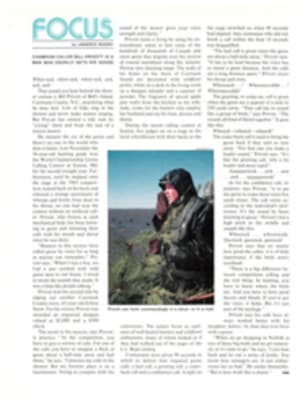
A FOREIGNER THREATENS THE INSULAR WORLD OF JAPANESE SUMO WRESTLING
Who goes by the nicknames Meat Bomb and Earthquake, weighs 491 pounds and has chauvinistic Japanese quaking in their geta? A 21-year-old Hawaiian named Salevaa Atisnoe, that's who. Never before has a foreigner advanced so far so fast in Japan's national sport, sumo wrestling, and patriots are panicking.
He is believed to be the biggest wrestler in the 1,500-year history of this sport of gargantuan men. Even Raiden, the "Superman" of the Edo Period, in the 18th century, was 100 pounds lighter. Atisnoe has already defeated some of Japan's finest wrestlers, and while no foreigner has ever ascended to sumo's summit, yokozuna, grand champion—there have been only 57 grand champions in the past 300 years—Atisnoe is expected to join them one day.
At home in Hawaii Atisnoe is usually called Sally, and no one makes a fuss about him when he visits. In Japan, where he is on magazine covers, where mothers hold up their children to be photographed next to him, and where he has replaced Goliath as a metaphor, he is called Konishiki, after a great champion of the Meiji Period (1868-1912), a rare honor for a young wrestler.
For months, he says, "I thought I was dreaming. I finally found out what I was doing was real." He speaks in a lilting voice deceptive in its suggestion of innocence. Japan, he says, is a good place, a peaceful place. But it is not always forgiving of outsiders who intrude upon the existing order.
Atisnoe first heard of sumo one afternoon on Waikiki Beach. It was during his final week of high school, a time to cut class. A man who had noticed his considerable heft—he then weighed 375—approached and inquired whether he might be interested in sumo. Atisnoe told him, "Not really. I don't know anything about sumo."
The stranger persisted. He was, Atisnoe was to learn, a friend of Jesse Kuhaulua's, a man who had left Hawaii 20 years before and had become a reasonably successful sumo wrestler. Atisnoe, the man had suggested, should talk to Kuhaulua. Atisnoe agreed. When the two met, Kuhaulua asked the youth to return to Japan with him. Atisnoe had college aspirations at the time but not the means. He was the seventh of eight children of a Navy maintenance worker and his wife, both Samoan by birth.
With little to hold him, and with little that otherwise compelled him—"I was just a big old bum," he says—Atisnoe accompanied Kuhaulua to Japan, where he joined the sumo "stable of the former grand champion Tagasako. He began to study Japanese while Kuhaulua helped him learn sumo moves and tactics, as well as the rules for proper behavior in this gesture-absorbed society.
With the other apprentice wrestlers, Atisnoe woke at five in the morning and practiced, sometimes outside in the rain. When the older wrestlers arrived, the young men would stand aside and wipe the dirt from their elders' shoulders and the sweat from the backs of their necks, or wash the older men's feet and make their lunches. The fledgling wrestlers would show their eagerness by rushing to the winner of each training bout and pleading to be chosen as his next opponent. Atisnoe readily accepted the discipline and the dictates of status. He found in the wrestling stable a kinship that approached family. During their schooling, the wrestlers live in a cloistered state. The younger ones are dissuaded from marriage until they are well along in their careers. They dine together on heavy wrestler's stew. And when they go out together for an evening, they stand apart, not only because they are so big, but also because their appearance suggests a different time: They dress in robes, and their hair is waxed, combed and tied in the long knots that are the wrestler's mark. (Atisnoe's hair is kinky, and he had to wait until it grew long before the attendant could fashion it into the appropriate knot.)
By last September Atisnoe started winning. He rose to the third-highest rank, Sekiwake, after only 15 tournaments. Even some of the best wrestlers in sumo seemed no match for him. He was runner-up in the first fall tournament in Tokyo and came close to winning, finishing with a 12-3 record. Defenders of the sport decried his size and strength, accusing him of winning without skill and with brutishness alone.
As an important November tournament approached, there was talk of an ad hoc "Stop Konishiki" campaign. Newspapers even speculated about strategies that might be devised to beat him—whether a practice injury might be inflicted intentionally, or whether foes might go so far as to lace his stew with sugar so that he might develop the overfed wrestler's curse, diabetes. Meanwhile, others speculated as to how soon he might become a grand champion.
"It doesn't show very much," he said one morning as the tournament neared, "but sometimes it hurts." A few nights before, he and some of the other wrestlers had gone to a disco, where a Japanese man approached and wished him well. This had heartened him, but he had grown irritable with the incessant questions about the most mundane aspects of his life and the resentment he caused in ways that, to him, seemed innocent.
He had, for instance, learned enough Japanese to answer for himself in interviews but not enough to learn that the language is filled with shaded meanings. So he told an interviewer that he regarded sumo as a fight, which, in appearance, it is. But aficionados lashed out at him, wondering how someone could regard their sport as mere combat. His answers became terse, and there were fewer attempts at pleasantries.
His first opponent in November was the aging grand champion Kitanoumi. No one had won more titles, but at 31 he was said to be fading. Still, the crowd adored Kitanoumi. The first bouts of the tournament had begun at 10 in the morning. Tournaments last for 15 days, and each wrestler must compete once a day—the better wrestlers going on last. Atisnoe appeared at the entrance to the packed arena just before six o'clock. He was naked but for his thick wrestler's strap. His shoulders were thrust back to support his great belly. His walk was a labored waddle. His fleshy, dimpled thighs kept his knees two feet apart.
Then Atisnoe and Kitanoumi stepped onto the raised clay ring, under the vaulted wooden roof that hung high above to create the atmosphere of a Shinto shrine. They went to their corners and began the preparation that precedes the quick bouts. First they stood on one leg and brought the raised leg down hard to stamp evil into the ground. They smacked their haunches and flanks and then squatted, facing each other, as they began the ceremonial clapping of hands to signal the gods. They leaned down and forward, balancing themselves on their fists, looking into each other's eyes. Kitanoumi rose, then Atisnoe.
They returned to their corners, took big handfuls of salt, the agent of purification, and cast them down. They purified themselves further by rinsing out their mouths and by wiping all sweat from their armpits. They repeated the posing and then did the ritual again. Each time Kitanoumi rose, Atisnoe glared, and the crowd roared as the anticipation built.
Atisnoe's glare was so purposely penetrating, so obvious, that it set him that much more apart from the Japanese wrestlers, who tend to regard each other with empty eyes.
The preparation period is limited to four minutes; when it ended, the wrestlers were poised, facing off a yard apart inside the 15'2" clay circle. Kitanoumi was first off the mark and hit the rising Atisnoe squarely. And though Kitanoumi weighs 375 pounds, it was as if he had run into a massive tree.
Atisnoe did not budge. Years ago Kitanoumi might have barreled over him, but now his charge was blunted, and Atisnoe countered. He could have tried to grab his opponent's strap and force him down with any number of techniques—but all he did was push. He extended his arms and shoved the older man back, his hands grabbing at Kitanoumi's neck and shoulders. Within five seconds the grand champion stood outside the straw boundary, defeated.
Under the stands, young girls waited with cameras. When Atisnoe appeared a thick crowd pressed around him, and he began his awkward trot to escape them. He could barely pass. Mostly it was younger people who reached out and patted him on the back.
In succeeding matches he faced only the best wrestlers, and some of them—using Atisnoe's own size and strength against him—beat him. Then, on the 11th day, with his record at 5 and 5, he was thrown. He landed so hard on his right shoulder that he had to be hospitalized. But though he had to withdraw from the tournament, attention remained on him. He was still a force to be reckoned with, an outlander threatening to become king of Japan's national sport. Atisnoe will soon be ready to fight again. No one is suggesting that the Meat Bomb has been defused.
PHOTO
YASUO MITO
At 491 pounds, Atisnoe is the largest sumo wrestler ever.
PHOTO
MINAMIKAWA SANJIRO
Atisnoe (right) and his former sumo teacher, Jesse Kuhaulua, settle down for a much-unneeded meal

